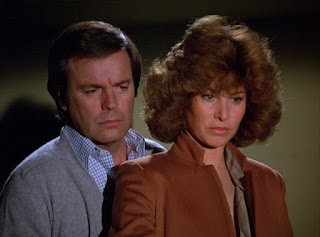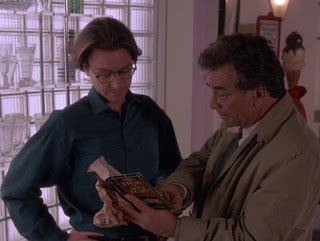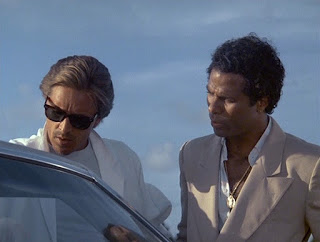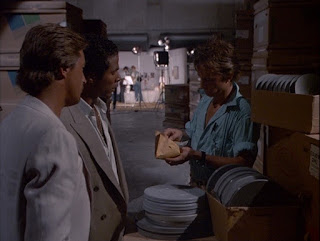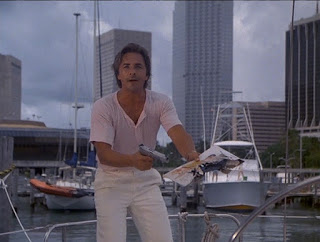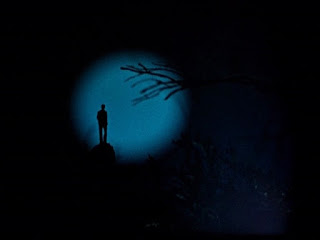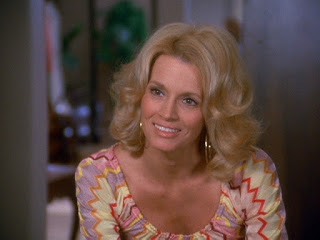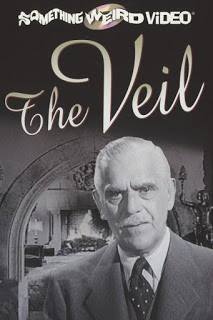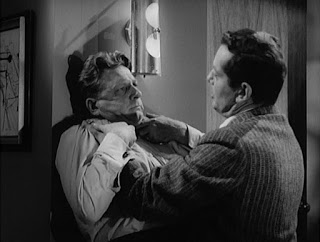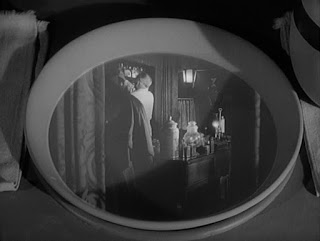Police Woman was not the first American TV series about a female undercover cop. That honour goes to Decoy, made way back in 1957. It was also not the first American TV series to feature an action heroine. Honey West beat it to the punch by a decade. Police Woman, which ran on NBC from 1974 to 1978 does however qualify as one of the iconic 70s American cop shows. And it did pave the way for other female-dominated action series such as Charlie’s Angels.
The first season was released on DVD by Sony in 2006 and it’s now difficult (and expensive) to acquire. The Shout! Factory releases of the second and subsequent seasons are much easier to find without breaking the bank which is why I’m reviewing the second season rather than the first.
It was Rio Bravo back in 1959 which launched Angie Dickinson’s career in a major way but it was Police Woman that made her a household name. As Sergeant Pepper Anderson (no-one agrees on what the character’s real first name is) she’s sexy and brash and tough and fairly hardboiled. She does have her vulnerable side and in one season two episode she’s on the point of quitting because she’s tired of being set up as a target all the time.
Earl Holliman plays her boss (and friend) Sergeant Bill Crowley with whom she has a mostly good professional relationship.
Dickinson and Holliman work very well together. There’s some flirtatiousness, some conflict and considerable respect between the two characters. It’s a slightly more complex relationship than you normally get in a cop show.
The other regular members of Crowley’s squad are Investigator Pete Royster (Charles Dierkop) and Investigator Joe Styles (Ed Bernard).
The first season gained a reputation for being quite violent, an aspect that was apparently toned down for the second season which went to air beginning in late 1975.
The show’s major selling point is of course Angie Dickinson. She was forty-three at the time the show premiered but she was still pretty glamorous. Her considerable sex appeal was heavily featured. And she certainly has charisma.
Police Woman does make some attempt to deal with the particular problems Pepper faces being both a cop and a woman. Not so much the professional challenges (Pepper is good at her job and no-one ever questions her competence) but the more interesting emotional challenges. Personally I think Decoy handled this aspect in a more interesting and complex way but Police Woman does at least try to address these issues.
Pepper Anderson is not a super-woman. She’s a well-trained professional who works as part of a team and her job is not to take on heavily-armed bad guys single-handed. A police woman who tried that would soon end up dead. A male police officer who tried that would soon end up dead as well. Successful cops don’t take stupid risks.
No 1970s American cop show is all that realistic – in the 70s the people who made TV shows understood that too much realism made for boring television. But Police Woman is, by the standards of the genre, at least not too wildly unrealistic.
Of course the emphasis here is on action (whereas for real-life cops the emphasis is on routine policework) and Police Woman provides plenty of satisfying action. This is not a Dragnet-style series about ordinary cops just doing ordinary routine police work. 70s audiences expected plenty of thrills.
Police Woman was considered to be quite violent by the standards of 70s American television. Of course if you compare it to its exact contemporary in Britain, The Sweeney, then Police Woman looks ridiculously tame.
If you want a realistic emotionally powerful TV series about a police woman, watch Decoy. If you want a fun action-packed series about a police woman then Police Woman delivers the goods.
Episode Guide
Pawns of Power is a pretty cynical season opener. Pepper is undercover at a moving casino (it’s in the back of a semi-trailer) but when the cops make the bust they discover they’ve blundered into an investigation by a high-powered state organised crime squad run by the oily Moulton (Roddy McDowall). Pepper has to stay undercover to take the place of one of Mouton’s people who’s been murdered, but Moulton doesn’t care how many people he puts at risk as long as he gets the big bust he wants. He’s quite happy to sacrifice Pepper and she knows it and she doesn’t like it one little bit. It’s a routine story but the depth of the cynicism makes it interesting.
In The Score druggies are dying from speed that is just too pure and too potent. The speed is coming from a new lab but the nice little dealing setup starts to go wrong when a courier absconds with the merchandise because she’s decided that dealing drugs is wrong. This episode is a bit of a mess, trying too hard to capture the drug culture atmosphere.
Paradise Mall is an improvement. A serial killer is targeting blonde women and he leaves the bodies wearing bridal veils. There are several possible suspects, some decent misdirection and a twist ending. It’s a bit contrived but it works extremely well.
Pattern for Evil involves an attempted Mob takeover of the garment trade. Pepper goes undercover, as a model naturally, which provides opportunities to have her running around in bathing suits. A solid episode.
In The Chasers Pepper gets knocked down by a dry cleaning truck. When she wakes up in the hospital she discovers, much to her surprise, that she’s retained a lawyer. She’s stumbled upon an ambulance-chasing racket. They don’t just take advantage of traffic accidents. They manufacture them. Pepper gets herself involved in order to get the evidence the cops need. The great Ida Lupino guest stars as an oily crooked social worker. It’s standard Police Woman stuff – Pepper right in the middle of things and getting herself into lots of danger, a decent enough script, some smooth villains and some action as the case turns into a case of triple murder. Another good solid episode.
Cold Wind opens with two guys who get shot to death as they arrive for work at a soft drink factory. There’s one promising suspect who has told the police a whole lot of lies and there’s another promising suspect whose car matched the description of one that was spotted leaving the murder scene. Pepper’s job is to get close to suspect number two. He’s a nice young man but a bit strange. There are some literary and artistic clues – a painting and a book, both called The Cold Wind which Pepper is pretty sure represents death. This above-average episode has a very nasty sting in the tail.
A parole officer is shot to death and in Above and Beyond Pepper goes undercover as a parolee. Parole officers tend to make enemies but this particular one was pretty popular. Pepper is offered a one-way trip to Mexico and the guy offering it could be the killer. This one gives Angie Dickinson the opportunity to be a bit hardboiled but she doesn’t overdo it. There are some obvious leads but after all any one of the guy’s parolees could have had some motive. There’s some decent misdirection, a very neat piece of deduction from a physical clue and at least one very good plot twist. A good episode.
In Farewell, Mary Jane the narcotics squad needs help. One of their informers, a former airline pilot named Klein (played by Lance LeGault of A-Team fame) has gone rogue and turned out to be a real bad guy after all and he’s crazy and dangerous as well. Crowley persuades a down-on-his-luck racing car driver to help out and the driver and Pepper pose as big-time dealers. There’s plenty of suspense and it’s a pretty good episode.
Pepper gets caught up in a bank robbery and taken hostage by a hillbilly gang who think they’re reliving some old movie in Blaze of Glory. Vern, the leader of the gang, wants to go out in a blaze of glory like Dillinger. Pepper manages to convince Vern and his brother Charlie Joe that she’s a hooker and that she’s on their side but Vern’s girlfriend Laurene hates Pepper at first sight. It’s a good action-filled chase episode.
In Glitter with a Bullet Pepper goes undercover as a reporter to investigate corruption in the record business. Tommy Donlevy is a big pop star but all is not well with Tommy. His friend and bass player Bobby died and the police suspect it was murder. Tommy’s band is very very 1970s – glitter and spangles. Tommy is being manipulated but he’s too crazy and strung-out to figure out what’s going on. There are some very nasty people around Tommy. If you believe this episode the record business in the 70s was an out-and-out racket, a world of sleazy deals and murder. It’s a bit silly but kind of money although it relies rather too much on clichés (including that old favourite of an attempt to kill the heroine by cutting her car’s brake line).
In The Purge Crowley shoots and kills a fifteen-year-old boy during a bungled raid on a warehouse. Crowley gets suspended and could face manslaughter charges. The sting that Pepper and a retired conman cook up to catch the bad guys is reasonably clever but the problem with this episode is that we’re supposed to be on the side of Crowley and the cops but they really don’t come out of the whole affair looking very good. The moral ambiguities needed to be explored a bit less simplistically but maybe prime-time TV in 1975 wasn’t ready for that.
Don’t Feed the Pigeons is about a particularly cruel gang of bunco artists preying on old ladies. Pepper infiltrates the gang. The scam is complicated and requires a detailed explanation which is slotted in reasonably effectively. Personally I always enjoy stories about complex con games so I liked this episode.
In The Hit we have gangsters and boxing, the world’s fattest bookmaker and the world’s most incompetent hitman. This hitman has made a mess of his last two hits but if he keeps trying maybe he’ll actually manage to kill someone. Pepper and Crowley and the squad have to try to make sure that doesn’t happen. A slightly odd but reasonably OK episode.
Silence has what seems to be a simple plot but it gets complicated. A mute girl named Glenna is worried about the disappearance of her sister Beth. She thinks Beth’s husband Julian may have murdered her. Pepper gets involved in the case because she knows sign language. The key evidence might possibly be found at Julian’s cabin on Frost Lake. Pepper stumbles across a clue that suggests that what is really going on maybe be something quite different. A good performance by the underrated Joanna Pettet as Glenna. Quite a good story, with the audience initially having no more idea than Pepper about where the truth lies.
A gang rumble leads to the shooting of a cop in Incident Near a Black & White. This one is a bit contrived and predictable and is mostly notable for featuring a dangerously incompetent senior police officer, and for the suggestion (unusual for 1975) that the police sometimes behave badly. We also get to see Crowley and Pepper in uniform dealing with routine incidents (there’s even an Adam-12 reference).
The Melting Point of Ice starts with a diamond robbery in which everything goes wrong. A jeweller is killed, one of the robbers is shot and then when they stash the uncut stones they get ripped off by a couple of amateurs. Pepper goes undercover selling coffee and burgers from the back of a truck – you won’t be surprised to learn that she sells a lot of coffee and burgers. The cops have to find those hapless amateurs before the professionals do. It’s nothing special but it’s a solid episode.
Pepper goes into business in The Pawn Shop. A well-organised burglary gang has been ripping off the rich folks of Lambert Hills. Crowley has the bright idea of setting up a pawn shop which will appear to be a front for a fencing operation. It’s not a bad story but the presence of Joan Collins as the guest star makes it a must-see. She plays a movie star who takes a shine to Crowley.
In Angela Crowley’s squad makes a big heroin bust but the cop, Larry, taking the evidence to the preliminary hearing manages to lose the evidence. The question is whether he lost it deliberately. No-one wants to think Larry is corrupt but the signs seem to point that way. Especially when it’s discovered he’s been dating a mobster’s daughter. An OK story, and darker and more hard-hitting than the average Police Woman episode.
Wednesday’s Child is a pretty routine episode. A cat burglar is facing a long stretch in prison if he doesn’t coöperate. The big problem for the cops is two witnesses who have to kept alive. It’s all just too predictable.
In Generation of Evil clean-cut college kid Steve Glass (played by Barry Williams, yes Greg Brady from The Brady Bunch) is kidnapped. The reason he’s been kidnapped is that he’s the grandson of gangster Morrie Hirsch. The kidnappers want two million dollars. Hirsch won’t co-operate with the police but they have a lead, which leads to Pepper going undercover as a Vegas showgirl so she can get close to sleazy casino operator Lou Malik (played with style by Robert Vaughn).
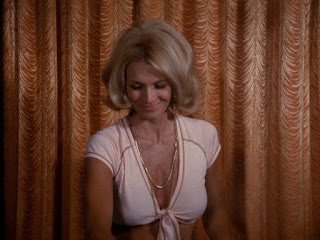
The most interesting thing about this episode is Morrie Hirsch. He was once a real big shot but now he’s a tired old man and he’s ailing and the only thing he cares about is his grandson. Now he discovers that he has no friends and nobody wants to help him out and he can’t get his hands on the two million and his world is falling down about his ears. He might have been a feared gangster once but now he’s an oddly sympathetic character, too stubborn to ask the police for help but increasingly desperate. So despite a routine plot this is quite a good character-driven episode.
Double Image starts with a blackmail racket, a variant of the old badger game, but it leads to murder. One of the participants in the blackmail scam offers to assist the police and Pete Royster is assigned to protect her. Unfortunately Pete gets much too emotionally involved. This really becomes the main focus of this episode (and it’s a very good episode).
In Mother Love a baby is kidnapped. The identity of the kidnapper comes as a surprise and the bad news is that she’s crazy and she’s prepared to kill to keep that baby. And she does kill. A reasonably entertaining episode with a nice double-cross twist.
Task Force: Cop Killer is a two-parter and it suffers from many of the typical problems of two-part episodes. It takes forever for the actual story to get going. Pepper is persuaded to apply for a paramilitary-style police motorcycle task force. I have no idea why a detective sergeant would want to do something like that. The last thing a detective would want to do is to go back in uniform and go back to issuing traffic citations. Pepper falls for a hot shot motorcycle cop named Matteo. While Matteo is romancing Pepper they’re being watched by a peeping tom, and Matteo know who the peeping tom is.
The motorcycle task force has a few run-ins with a biker gang. There’s a suspicion that a state senator’s daughter who ran away from home a few years earlier is riding with the gang. Finally, after an hour of pointless riding around on motorcycles the plot starts to kick in when a cop gets run over by a van.
The second part is a marginal improvement. There’s an obvious suspect, and there’s a dead girl’s body found in a ravine. Naturally Pepper manages to get herself kidnapped yet again. As a one-hour episode this one might have worked but there’s not enough plot for two hours and the motorcycle task force stuff is a bit creepy. A disappointing end to an otherwise pretty decent season.
Final Thoughts
Police Woman holds up pretty well and it has Angie Dickinson’s star power. Highly recommended.


